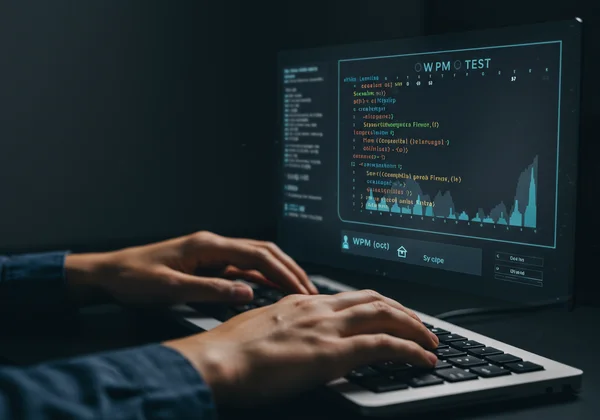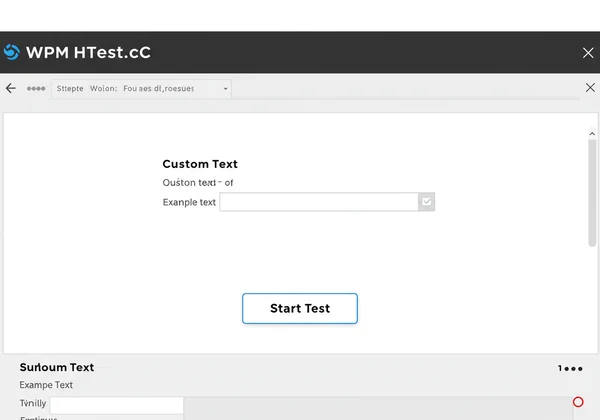Custom WPM Test: Advanced Typing Drills to Boost Your Speed & Accuracy
Generic typing tests are a great starting point, but do they reflect your daily work? For professionals, speed and accuracy are not just about typing random words; they are about mastering the specific vocabulary, syntax, and formats that define your career. This is where custom typing practice becomes a game-changer. How can I improve my typing speed for specialized texts? The answer lies in training with material you actually use, transforming your keyboard into a powerful tool for professional efficiency.
On our WPM typing test platform, we believe in targeted training. Our online platform isn't just a basic typing speed test; it's a personal training ground where you can take a custom WPM test. You can move beyond generic paragraphs and use our custom text feature to practice what truly matters. This guide provides 15 specialized drills for programmers, legal professionals, and writers. Copy them, paste them into our free WPM test, and start seeing real-world improvement today.

Programmers: Boost Your Typing Speed with Custom Code Drills
For developers, typing speed is directly linked to productivity. Every moment spent correcting a typo in a variable name or fumbling with special characters is a moment lost from solving complex problems. Generic typing speed tests don't prepare you for the unique rhythm of coding, which is filled with symbols, indentation, and specific syntax that demands muscle memory.
Improve Typing Accuracy: Essential for Error-Free Code Input
A single misplaced semicolon can break an entire application. Efficient coding requires more than just knowing the language; it involves fluidly translating thoughts into syntactically perfect code. Improving your keyboard skills for programming means fewer interruptions, faster debugging, and a more streamlined development workflow. Accuracy isn't just a goal; it's a requirement.
Essential Code Snippets for Practice
Practice these common patterns to build muscle memory for your most-used languages. Each snippet serves as a mini typing test for your coding skills. Focus on accuracy before speed.
- Python Function:
def calculate_average(numbers): total = sum(numbers); return total / len(numbers) if numbers else 0 - JavaScript Arrow Function:
const getUser = (id) => fetch(\api.example.com/users/${id}`).then(res => res.json());` - SQL Query:
SELECT customer_id, first_name, COUNT(order_id) FROM orders WHERE status = 'shipped' GROUP BY customer_id; - HTML Structure:
<div class="container"><section><h2>Welcome!</h2><p>This is a sample paragraph.</p></section></div> - CSS Styling:
body { font-family: 'Arial', sans-serif; line-height: 1.6; color: #333; background-color: #f4f4f4; }
Navigating Brackets, Operators, and Special Characters
The true challenge of code typing lies in the non-alphabetic keys. Drills that focus on (), {}, [], =>, &&, ||, and !== can dramatically reduce errors. Create your own drills by combining these symbols or use the ones above. Consistent practice helps your fingers find these keys without looking, making your coding seamless. Ready to build that muscle memory? Practice your code on our platform now.

Legal Typing Test Practice: Mastering Jargon for Professionals
In the legal field, precision is paramount. A typo can alter the meaning of a contract or legal brief, leading to serious consequences. Legal typing practice must go beyond standard prose to include the complex terminology, citations, and formatting unique to the profession. Regular practice ensures that accuracy becomes second nature.
The Importance of Error-Free Legal Transcription
From client intake forms to court filings, legal documents are built on accuracy. High-stakes transcription requires a typist to be both fast and flawless. Improving your transcription accuracy means you can produce clean, reliable documents more efficiently, saving valuable time for billable hours and critical legal analysis. The goal is to make typing an unconscious skill, freeing your mind to focus on the content.
Practice Texts: Contracts, Motions, and Briefs
Incorporate these phrases and clauses into your daily practice to master common legal jargon.
-
Contract Clause:
This Agreement shall be binding upon and inure to the benefit of the parties hereto and their respective heirs, legal representatives, successors, and assigns. -
Motion Language:
COMES NOW the Defendant, by and through their undersigned counsel, and hereby moves this Honorable Court to dismiss the complaint pursuant to Rule 12(b)(6). -
Deposition Excerpt:
State your full name and address for the record. Please recall the events of the morning of June 5th, 2023, to the best of your ability. -
Standard Objection:
Objection, your Honor. The question calls for speculation and assumes facts not in evidence. It is leading and argumentative. -
Legal Citation:
As established in Marbury v. Madison, 5 U.S. 137 (1803), the principle of judicial review grants the courts the authority to declare a law unconstitutional.

Writers & Content Creators: Typing Speed Tests for Creative Flow
For writers, authors, and content creators, typing is the bridge between idea and page. When your fingers can keep up with your thoughts, your creativity can flourish. Typing exercises for writers should focus on narrative flow, dialogue, and complex punctuation to ensure the mechanics of writing never become a bottleneck for your creative process.
Sustaining Creative Flow with Faster Input
The faster you can get words onto the page, the more connected you remain to your initial spark of inspiration. Slow, deliberate typing can interrupt your creative flow, causing you to lose your train of thought. By increasing your typing speed, you shorten the distance between your imagination and the final product, allowing for more fluid and authentic writing. Take a typing speed test to see where you currently stand.
Mastering Narrative, Dialogue, and Punctuation
Writers use punctuation to create rhythm, tone, and clarity. Practice these sentences to master the art of typing complex narrative and dialogue structures.
-
Complex Narrative:
He paused, glancing over his shoulder—a reflexive, almost paranoid tic—but the rain-slicked alley remained empty, save for the swirling steam from a nearby vent. -
Dialogue with Action:
"I won't allow it," she said, her voice dropping to a whisper. He slammed his fist on the table. "You don't have a choice!" -
Punctuated Series:
The market was a riot of colors, sounds, and smells: vibrant red peppers, the high-pitched haggling of vendors, and the earthy aroma of fresh-baked bread. -
Internal Monologue:
What if I'm wrong? The question echoed in her mind, a relentless drumbeat of doubt that threatened to unravel everything she had built. -
Figurative Language:
The old house groaned under the weight of the storm, its windows like vacant eyes staring out into the tempestuous, unforgiving night.

Master Custom Typing Drills on WPMTest.cc: A Step-by-Step Guide
Now that you have professional-grade drills, it's time to put them into practice. The true power of our platform lies in its flexibility. Our custom text feature is designed specifically for this kind of targeted training, allowing you to measure your speed and accuracy on the content that matters most to you.
Step-by-Step Guide to Importing Your Practice Texts
Follow this simple step-by-step guide to begin your specialized training in seconds.
-
Navigate to the WPMTest.cc homepage.
-
Locate the WPM test window in the center of the page.
-
Click on the "Custom Text" or similar option to activate the custom typing test input field.
-
Copy any of the 15 drills provided in this article (or your own text).
-
Paste the text directly into the custom field.
-
Click "Start Test" or simply begin typing to start the timer and get instant feedback.

Tips for Maximizing Your Custom Practice Sessions
To get the most out of your training, keep these tips in mind. First, prioritize accuracy over speed. Fast typing with many errors is counterproductive. Slow down until you can type the drill with 98% accuracy or higher, then gradually increase your speed. Use the one-minute test for a quick warm-up and the three or five-minute tests to build stamina. Consistently practicing with custom drills is the fastest way to break through a typing plateau and achieve tangible gains in your professional work.
Unlock Your Professional Typing Potential Today
Your professional skill set deserves professional training tools. Stop practicing with generic word lists on a standard typing test and start honing the typing skills that will actually advance your career. By leveraging the custom practice drills in this guide, you can directly improve your efficiency, accuracy, and confidence as a programmer, legal professional, or writer.
Ready to become a faster, more accurate typist? It starts with consistent, relevant practice. Our online WPM test provides the accessible and powerful platform you need to get there. Choose a drill, test your wpm today, and take the first step toward unlocking your true productivity potential.
Frequently Asked Questions About Specialized Typing Drills
What is a good WPM score for professionals in my field?
While the general average is around 40 WPM, professionals often aim higher. Programmers benefit from scores of 60+ WPM to handle complex syntax efficiently. Legal and administrative professionals often target 70-90 WPM for transcription and document preparation. Writers find that 70+ WPM helps maintain creative flow. The best score is one that ensures your typing speed is never a bottleneck in your workflow.
How can I improve my typing speed specifically for specialized texts?
The key is consistent, focused practice with relevant material. Use the custom text feature on a platform like WPMTest.cc to drill the vocabulary, symbols, and sentence structures you encounter daily. Focus on accuracy first, then gradually build speed. This method trains your muscle memory for the exact patterns you need for your job.
How is WPM calculated during a custom typing test?
WPM (Words Per Minute) is calculated using a standard formula. The total number of characters typed (including spaces) is divided by 5 to determine the number of "words." This number is then divided by the test duration in minutes. For example, in a 1-minute test, typing 300 characters is equivalent to 60 WPM. Our WPM test calculates this for you instantly, along with your accuracy rate.
Can using custom text drills truly help me break my WPM plateau?
Absolutely. A typing plateau often occurs because you have mastered common words and finger patterns but struggle with less frequent ones. Custom drills force you to practice your specific professional "weak spots," whether that's coding symbols, legal jargon, or complex punctuation. This targeted practice builds new muscle memory and is one of the most effective strategies for pushing past a plateau.